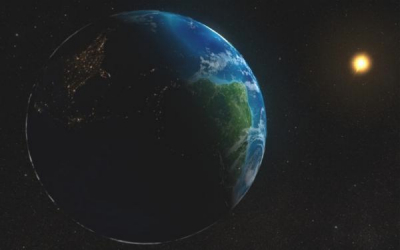Chapter 4
Energy and Radiation
Sunrise over South America
Courtesy NASA
Solar radiation is the source of energy that drives most environmental processes acting at the surface of the Earth. The spatial variation of energy affects the spatial variation of temperature, wind, and moisture which determine the geography of soils, vegetation, climate and landforms. The awesome power of hurricanes is driven by the heating of water and subsequent heat release during condensation. Unequal heating of the Earth's surface creates wind that heaps sand into great dunes.
The animation of net radiation below shows
the amount of energy absorbed or lost by the earth. Orange
to red areas are those where the earth is gaining energy,
and the blue regions where energy is being lost. Examine
the animation by clicking the play button and describe
what you see. Use the slider to control the timing
yourself. What patterns do you see?
Seasonal changes in net radiation
Courtesy NASA Earth Observatory (Source)
The most noticeable pattern revealed is the seasonal change in where regions of positive and negative net radiation occurs. Regions of positive net radiation and energy gain occur during the summer months, and thus shifts from northern to southern hemisphere. Large positive net radiation appear in the tropics, large negative at the poles. Why does this spatial and temporal pattern in net radiation occur and what are the implications? Will this pattern change in the future?
Learning Outcomes:
By the end of the chapter you should be able to:
- Compare and contrast energy, heat and temperature.
- Define sun angle, solar declination, daylength, and describe their geographical variation through the seasons.
- Calculate the noon sun angle for any latitude on the solstices and equinoxes.
- Explain the global pattern of insolation, net radiation, sensible heat and latent heat.
See if you are prepared for this chapter by Getting Ready for Chapter 4: Energy and Radiation.
You may view a list of chapter topics by clicking the "Topic Outline" link or go directly to the first topic by clicking "Continue".
Previous | Topic Outline| Continue

